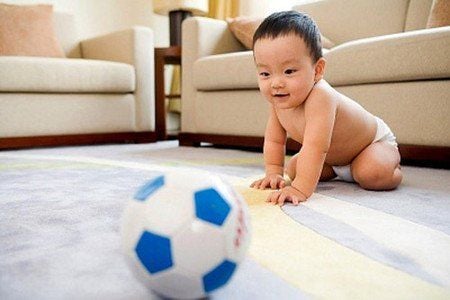This is an automatically translated article.
The article was professionally consulted by Specialist Doctor I Dang Thi Ngoc Chuong - Department of Pediatrics - Neonatology, Vinmec Central Park International General Hospital. The doctor has extensive experience in the diagnosis and examination of neonatal pathology - neonatal resuscitation.As the baby gains control over his head and at the same time he will learn to sit on his own with the support of the babysitter, and at the same time he will learn to roll over. Eventually, they'll learn to roll from back to belly and vice versa, and they'll use their newfound skill to roll around. Parents should encourage these early activities so that children can develop better motor skills.
1. When does the child learn to flip?
Your baby may be able to kick his or her own feet, from tummy time, as early as 4 months old. Parents are also very interested in the issue of "Children know how to turn over". For this activity, it may take about 5 or 6 months for your baby to turn from back to front. Because babies need stronger neck and arm muscles for that movement.Trắc nghiệm: Sự phát triển tinh thần, vận động của bé thế nào là đúng chuẩn?
Khi nào bé biết nói, biết hóng chuyện hay biết cầm cốc là "đúng chuẩn"? Điểm xem bạn biết được bao nhiêu mốc phát triển tinh thần, vận động "đúng chuẩn" của bé nhé!The following content is prepared under supervision of Thạc sĩ, Bác sĩ y khoa, Ma Văn Thấm , Nhi , Phòng khám Đa khoa Quốc tế Vinmec Dương Đông(Phú Quốc)
2. How babies learn to roll over and over
Around 3 months old, when placed on his stomach, he will raise his head and shoulders, and he will use his arms for support. This little push-up helps your baby strengthen the muscles he or she will use to roll over and over later. Your baby will surprise you (and the baby himself, by what's going on). The first time the baby turned over. (Although babies often roll from front to back, it's perfectly normal to do activities the other way around.)By 5 months, your baby will probably be able to hold his head up and down. arms and arch your back to lift your chest off the ground. They can even lie on their stomachs, kick their legs and swim with their arms.
All of these exercises help your baby develop the muscle action needed so he can roll over in both directions or different directions. This will happen when the baby is about 6 months old. Even babies can learn to flip earlier than their age.

3. How to help your baby roll over and over
You can encourage your child's new skills through games. If you notice your baby rolling back and forth spontaneously, see if they can try this again with a nearby toy that they usually roll over. Or lie down next to your baby on one side, within easy reach, and see if he rolls to get closer to you. Praise your baby's efforts and smile every time he or she completes an activity. This will stimulate them to work more and the manipulation will be more flexible. Maybe rolling over will bring a little joy to your baby, but you should also be careful and supportive when doing these activities for the first time.Although your baby may not be able to roll over until about 5 months, it's best to hold hands and support your baby during this activity from the start. You should be careful, do not leave the child unattended on the bed or any other high surface. Because a child's first rollover can lead to serious injury.
4. What to do if the child does not roll over and over?
If your baby still hasn't learned how to roll over one way or another by about 6 months, he hasn't yet transitioned to sitting and is instead trying to crawl and roll. At this point, you can talk to your pediatrician to find out the cause and how to help your baby.Newborns develop different skills. In some children, some of their skills may develop faster than others. And some kids are never really able to roll over and over. For premature babies, however, it's important to remember that premature babies may reach this and other milestones later than their peers.

5. After the baby sits up and what activity will happen next?
Your baby has developed muscles in his legs, neck, back and arms during rolling. Your baby will now be working those muscles as he learns to sit and crawl. Most babies have mastered sitting up between 6 and 8 months. However, the baby's crawling may come a little later.When children begin to know how to turn, sit, crawl, their motor abilities have developed very strongly. Therefore, paying attention to the safety of children should be a top priority. Parents should stay with their children to support their best development and movement.
Pediatrics department at Vinmec International General Hospital is the address for receiving and examining diseases that infants and young children are susceptible to: viral fever, bacterial fever, otitis media, pneumonia in children, ... With modern equipment, sterile space, minimizing the impact as well as the risk of disease spread. Along with that is the dedication from the doctors with professional experience with pediatric patients, making the examination no longer a concern of the parents.
Please dial HOTLINE for more information or register for an appointment HERE. Download MyVinmec app to make appointments faster and to manage your bookings easily.
Reference source: babycenter.com














